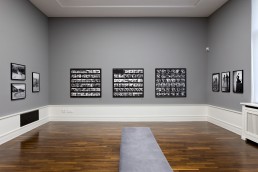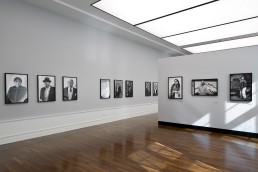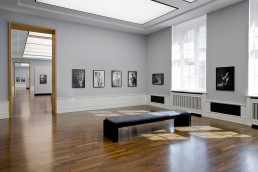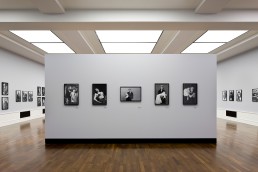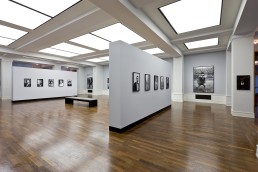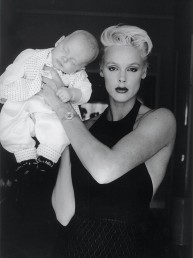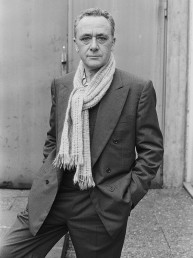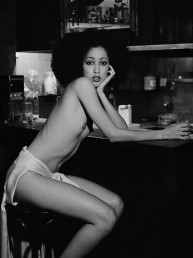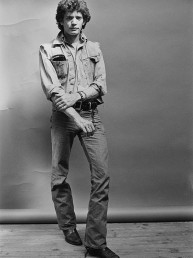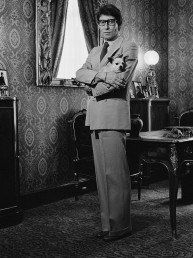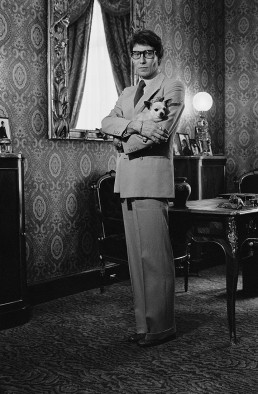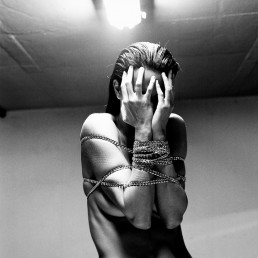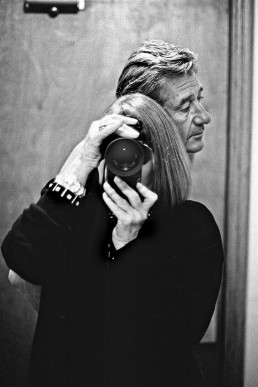Starting in 1970, June Newton created own photographic works under the pseudonym Alice Springs. These have been exhibited regularly at the Helmut Newton Foundation since 2005, namely in “June’s Room”. For the first time the retrospective Alice Springs provided a comprehensive look at the four decades that span her work, presenting photographs from advertising and fashion as well as nudes and portraits.
Her own photographic oeuvre began with a bout of influenza suffered by Helmut Newton in Paris, 1970. June Newton had her husband show her how to handle the camera and light meter and in his place photographed an advertisement for the French cigarette brand Gitanes. The portrait of the smoking model would be the jumpstart of a new career. In the early 1970s, Alice Springs shot several campaigns for the French hair stylist Jean Louis David; the photographs appeared under her byline as full-page ads in renowned fashion magazines. 1974 saw the first Alice Springs cover image adorning French Elle.
By this time she had also received innumerable commissions for portraits, some of which have become iconic. The roster of artists, actors and musicians depicted by Alice Springs over the last 40 years reads like a who’s who of the international cultural scene on both sides of the Atlantic. Many portraits were magazine assignments from Paris to Los Angeles; others resulted from private initiative.
Alice Springs does more than document the appearance of celebrities and anonymous contemporaries; she captures their charisma, their aura. Her eye for people is mostly concentrated on people’s faces. Occasionally she narrowly frames her subjects in a half- or three-quarters’ length portrait, where the hands receive special attention as well. It might be that her deep knowledge of acting helps, how to simultaneously look at and beyond the human façade. This is particularly evident in her double portraits, in which the protagonists’ interaction is perfectly staged.
There is a certain sense of familiarity in her images; actually they oscillate between distance and intimacy. In her subtle portraits we encounter the haughty stance alongside natural self-confidence as well as the shy glance. Dramatic poses are seldom, and the process occurs without grand gestures on the part of the photographer. Her images are visual commentaries that interpret the photographed.
Selected Works
Alice Springs
Matthias Harder
Starting in 1970, June Newton created own photographic works under the pseudonym Alice Springs. These have been exhibited regularly at the Helmut Newton Foundation since 2005, namely in “June’s Room”. For the first time the retrospective in Berlin provided a comprehensive look at the four decades that span her work, presenting photographs from advertising and fashion as well as nudes and portraits.
Her own photographic oeuvre began with a bout of influenza suffered by Helmut Newton in Paris, 1970. June Newton had her husband show her how to handle the camera and light meter and in his place photographed an advertisement for the French cigarette brand Gitanes. The portrait of the smoking model would be the jumpstart of a new career. A trained theater actress, who due to language barriers saw few chances for employment in France, she had received brush and canvas from her husband and was teaching herself to paint. After the ad for Gitanes, José Alvarez, director of a creative agency in Paris at the time, gave her commercial assignments for pharmaceutical ads. Later it was Alvarez, as head of Editions du Regard, who published her first book of portraits in 1983. By the mid-1970s she had received innumerable commissions for portraits, some of which have become iconic.
The roster of artists, actors and musicians depicted by Alice Springs over the last 40 years reads like a who’s who of the international cultural scene on both sides of the Atlantic – from Yves Saint Laurent and Karl Lagerfeld to Billy Wilder and Diana Vreeland, Gerhard Richter and even the Hell’s Angels. And although the majority of her subjects count among the international jet set, Alice Springs is not one to discriminate along social strata. Many portraits were magazine assignments from Paris to Los Angeles; others resulted from private initiative. Different from many of her colleagues, Alice Springs takes a more intimate approach, reacting spontaneously in surprising photographic situations – lending her protagonists an aura of vulnerability, while maintaining their individuality.
The intensity expressed by such diverse artistic figures would hardly have been possible without the photographer’s great talent in communication, along with impressive psychological insight. Many artists, like other celebrities, are known for their vanity. It might be expected that they would welcome photographic sessions whose published results could bolster their fame. Still, on occasion a kind of duel between photographer and model occurs – when the camera becomes a weapon. In a portrait, the creative spirit is essentially forced into a passive role. The photographer must go beyond mere documentation and create something special, augmenting the artist’s preexisting image with something that is new and unusual, free of cliché. Alice Springs succeeds in doing this time and again. It might be that her deep knowledge of acting helps, how to simultaneously look at and beyond the human façade. This is particularly evident in her double portraits, in which the protagonists’ interaction is perfectly staged.
Alice Springs does more than document the appearance of celebrities and anonymous contemporaries; she captures their charisma, their aura. The silent dialogue leading to such exceptional portraits seems grounded in a kind of spiritual kinship. Her eye for people is mostly concentrated on people’s faces. Occasionally she narrowly frames her subjects in a half- or three-quarters’ length portrait, where the hands receive special attention as well. Her subjects look curiously, candidly and directly into her small format camera – a seldom occurrence in contemporary photography. There are only a few studio portraits; the majority are taken in public spaces, in front of or inside her protagonists’ homes. There is a certain sense of familiarity in her images; actually they oscillate between distance and intimacy. In her subtle portraits we encounter the haughty stance alongside natural self-confidence as well as the shy glance. Dramatic poses are seldom, and the process occurs without grand gestures on the part of the photographer. Her images are visual commentaries that interpret the photographed. Despite the intimacy and intensity with which she works, the photographer never betrays her subjects.
In the early 1970s, Alice Springs shot several campaigns for the French hair stylist Jean Louis David; for many years the photographs appeared under her byline as full-page ads in renowned fashion magazines such as Elle, Vogue, Marie Claire, and Nova. She started shooting fashion editorials for the magazine Dépèche Mode in 1971, and three years later saw the first Alice Springs cover image adorning French Elle. Selected motifs from her early advertising and fashion photography thus appeared at the start of this retrospective exhibition; here young, self-confident women often take the center stage of her visual universe. We also encounter them in her somewhat provocative nudes from the 1970s that capture (apparently) lesbian couples in the act of erotic play.
Alongside the more known portraits by Alice Springs, her early commercial and fashion photographs as well as nudes are thus presented in this first retrospective comprised of some 250 images. For this survey of her work, the photographer chose not to show her numerous self-portraits and pictures of her husband, which were already shown in Us and Them for the grand opening of the museum in June 2004.
Helmut and June Newton, who at the time was still known as June Browne, met and fell in love in 1946 in Melbourne. A year later they married. In 1956 they went to London where Helmut Newton took a full-time position as photographer for the UK edition of Vogue. After a year they returned to Australia, only to leave for good in 1961 and settle in Europe. They lived in Paris for two decades, and from 1981 in Monaco and Los Angeles.
Not only the majority of Helmut Newton’s photographs were realized in these cities, but also those of Alice Springs. She regularly accompanied her husband on his travels as well, where she documented him during his work – for example in Hawaii, as we can see here for the first time. The circle closes time and again; the life and work of the couple was manifold intertwined.
